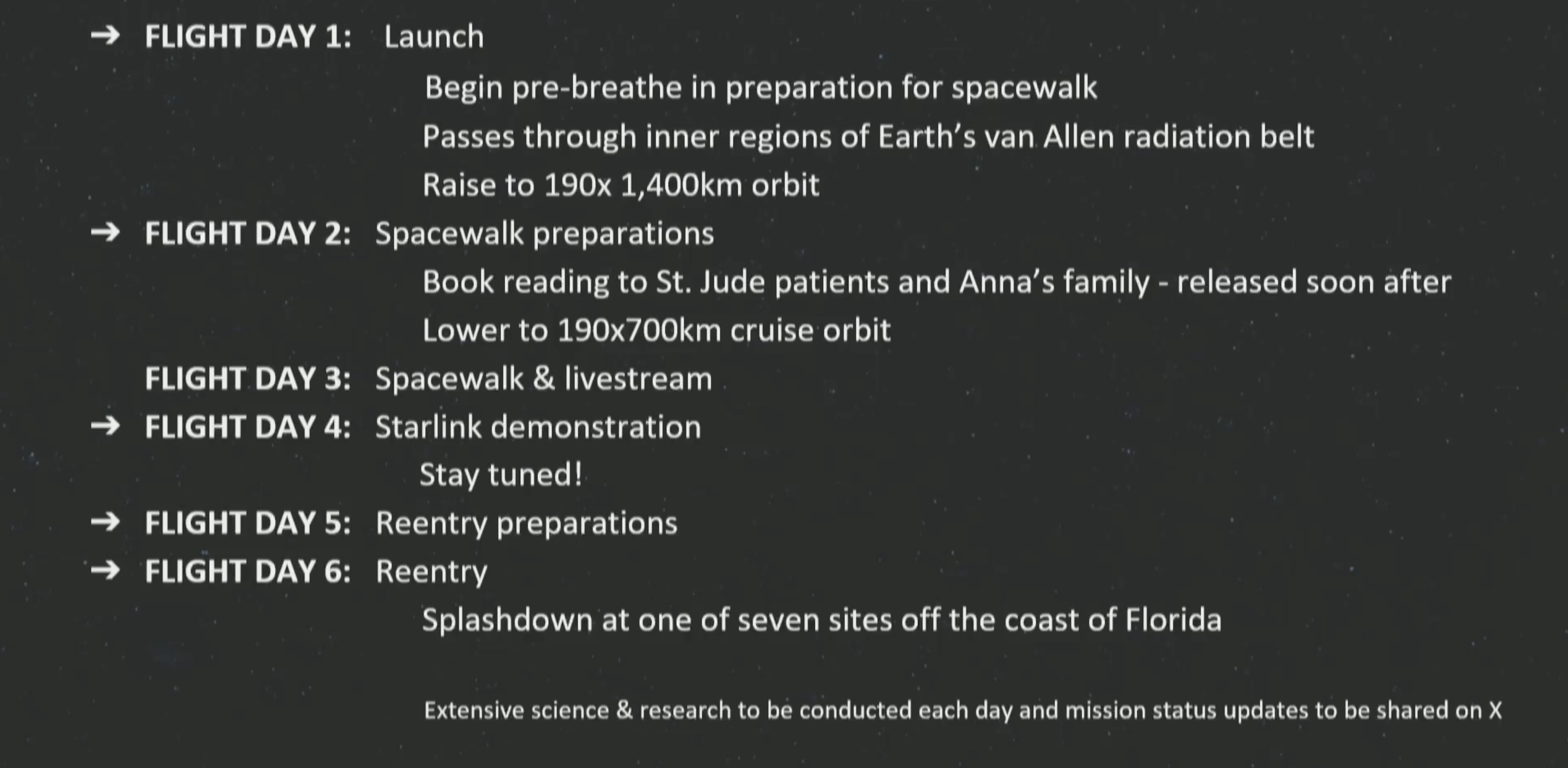
A SpaceX rocket will launch four people into space on the private Polaris Dawn mission this week and if you want to watch the liftoff live, you’ll need to know when and where to watch. And in this case, it might help to be an early bird.
The Polaris Dawn mission, a commercial spaceflight backed by American billionaire Jared Isaacman that will attempt the first private spacewalk, is currently scheduled to launch on Tuesday, Aug. 27, on a Falcon 9 rocket and the Crew Dragon capsule Resilience. Liftoff is scheduled for 3:38 a.m. EDT (0738 GMT) from Florida’s Cape Canaveral.
Here’s a look at what time Polaris Dawn will fly, how to watch live online, who’s on board and how long the mission will last.
What time is SpaceX’s Polaris Dawn launch?
SpaceX is currently targeting 3:38 a.m. EDT (0738 GMT) on Tuesday to launch the Polaris Dawn mission, but does have a four-hour window in which to fly. That means the launch could occur anytime between 3:38 a.m. EDT and 7:38 a.m. EDT (1138 GMT).
Polaris Dawn will liftoff from SpaceX’s pad at Launch Complex 39A of NASA’s Kennedy Space Center in Cape Canaveral, Florida. SpaceX has at least two opportunities to launch within the four-hour window, the company has said.
SpaceX rolled the Dragon spacecraft and its Falcon 9 rocket on the pad on Saturday (Aug. 24), and conducted a static fire of the Falcon 9’s first-stage engines a day later. The Polaris Dawn crew, meanwhile, performed a dress rehearsal for launch day on Aug. 25.
Can I watch SpaceX’s Polaris Dawn launch online?
Yes, you can watch SpaceX’s Polaris Dawn launch live online. SpaceX will provide a live webcast on its X channel (formerly Twitter), starting about 3.5 hours before liftoff.
Since SpaceX has scheduled the launch for 3:38 a.m. EDT, the livestream should begin shortly after 12 a.m. EDT (0400 GMT). You can also watch the livestream at the top of this page, as well as on Space.com’s YouTube channel, which will simulcast the launch.
Who is flying on SpaceX’s Polaris Dawn mission?

SpaceX’s Polaris Dawn mission will launch four private astronauts to space on a commercial flight financed by billionaire Jared Isaacman, who has already flown in orbit once with SpaceX in 2021’s Inspiration4 mission. Here’s a look at who’s joining him on the mission. For a more in-depth look at the astronauts, check out our meet the Polaris Dawn crew story.
- Jared Isaacman: Isaacman is the financier of the Polaris Dawn and serves as the commander of the mission. The entrepreneur made his fortune as founder and CEO of Shift4Payments, a payment processing company. After Inspiration4, Isaacman purchased three more flights from SpaceX under his Polaris Program. Polaris Dawn is the first of those flights. He has logged over 6,000 hours flying high performance aircraft.
- Scott “Kidd” Poteet: Poteet is a retired U.S. Air Force Lieutenant Colonel and serves as the pilot of the Polaris Dawn mission. Polaris Dawn will be his first trip to space. He has logged over 3,200 hours flying jet aircraft and spent 20 years in the Air Force. He has previously served as director of business development at Draken International (a company Isaacman once owned, vice-president of strategy at Shift4 and was the mission director of Inspiration4.
- Sarah Gillis: Gillis is a mission specialist on Polaris Dawn and is SpaceX’s lead space operations engineer in charge of astronaut training. She was the mission trainer for Isaacman’s Inspiration4 flight. Gillis joined SpaceX as an intern in 2015 and studied aerospace engineering and dance at the University of Colorado, Boulder.
- Anna Menon: Menon is a mission specialist and chief medical officer of the Polaris Dawn crew. She is also SpaceX’s lead operations engineer for crew operations development, and has served as a flight controller for the company’s Demo-2 nd Crew-1 flights. Prior to joining SpaceX, Menon was a biomedical flight controller for the International Space Station, worked with Engineers Without Borders and is a private pilot. In addition to her Polaris Dawn duties, Menon also wrote a children’s book “Kisses from Space” with Keri Vesak, which she will read from space. Proceeds from the book will help support St. Jude Children’s Research Hospital.
How long is SpaceX’s Polaris Dawn mission

From liftoff to Falcon 9 booster landing, SpaceX’s Polaris Dawn launch should last about 8.5 minutes, but the actual flight will last much longer.
Isaacman and his crew plan to spend at least five days in orbit during their private spacewalk. During that time, the crew will break the record for the highest spaceflight by female astronauts and also fly on the highest human spaceflight since the Apollo era.
Isaacman and the crew will also attempt the world’s first private spacewalk on flight day 3, test a new orbital Starlink communications link on flight day 4 and conduct nearly 40 experiments while in orbit. A key experiment is the testing and demonstration of SpaceX’s new spacesuits for spacewalking.

| Time (hr:min:sec) | Event | Header Cell – Column 2 |
|---|---|---|
| T-00:45:00 | SpaceX Launch Director ‘Go’ for Fueling | Row 0 – Cell 2 |
| T-00:42:00 | Crew Access Arm Retracts | Row 1 – Cell 2 |
| T-00:39:00 | Dragon Launch Escape System Armed | Row 2 – Cell 2 |
| T-00:35:00 | RP-1 propellant loading begins | Row 3 – Cell 2 |
| T-00:35:00 | 1st stage liquid oxygen (LOX) loading begins | Row 4 – Cell 2 |
| T-00:16:00 | 2nd stage LOX loading begins | Row 5 – Cell 2 |
| T-00:07:00 | Falcon 9 engine chilldown begins | Row 6 – Cell 2 |
| T-00:5:00 | Dragon on internal power | Row 7 – Cell 2 |
| T-00:01:00 | Flight computer prelaunch checks | Row 8 – Cell 2 |
| T-00:01:00 | Fuel tanks at flight pressure | Row 9 – Cell 2 |
| T-00:00:45 | Launch Director gives ‘GO’ for launch | Row 10 – Cell 2 |
| T-00:00:03 | Ignition Sequence Start | Row 11 – Cell 2 |
| T-00:00:00 | Falcon 9 Liftoff! | Row 12 – Cell 2 |
| T+00:00:58 | Max Q | Row 13 – Cell 2 |
| T+00:02:26 | 1st stage main engine cutoff | Row 14 – Cell 2 |
| T+00:02:29 | Stage Separation | Row 15 – Cell 2 |
| T+00:02:37 | 2nd stage engine start | Row 16 – Cell 2 |
| T+00:02:43 | 1st stage boostback burn starts | Row 17 – Cell 2 |
| T+00:03:30 | 1st stage boostback burn ends | Row 18 – Cell 2 |
| T+00:06:16 | 1st stage entry burn starts | Row 19 – Cell 2 |
| T+00:06:27 | 1st stage entry burn ends | Row 20 – Cell 2 |
| T+00:07:21 | 1st stage landing burn | Row 21 – Cell 2 |
| T+00:07:38 | 1st stage landing | Row 22 – Cell 2 |
| T+00:08:49 | 2nd stage engine cutoff | Row 23 – Cell 2 |
| T+00:11:55 | Dragon separation | Row 24 – Cell 2 |
| T+00:12:43 | Dragon nosecone opens | Row 25 – Cell 2 |
What if SpaceX’s Polaris Dawn mission can’t launch on time?
While SpaceX is targeting a 3:38 a.m. EDT launch on Aug. 27 for the Polaris Dawn crew, the company could delay or scrub the mission due to technical or weather issues. As such, the company has a backup launch opportunity, with liftoff scheduled for the same time of day.
If an issue prevents Polaris Dawn’s launch on Aug. 27, SpaceX could try again on Aug. 28 at 3:38 a.m. EDT. As with the Aug. 27 attempt, SpaceX would have a four-hour window in which to launch the mission, with two chances to fly during that window.
In fact, SpaceX has already delayed the launch by one day. It was originally scheduled to launch on Monday, Aug. 26, with SpaceX postponing the flight by 24 hours to allow time for extra rocket checks.
You can watch SpaceX’s Polaris Dawn launch live on Space.com on launch day, courtesy of SpaceX’s X stream, starting at about 12 a.m. EDT (0400 GMT).







